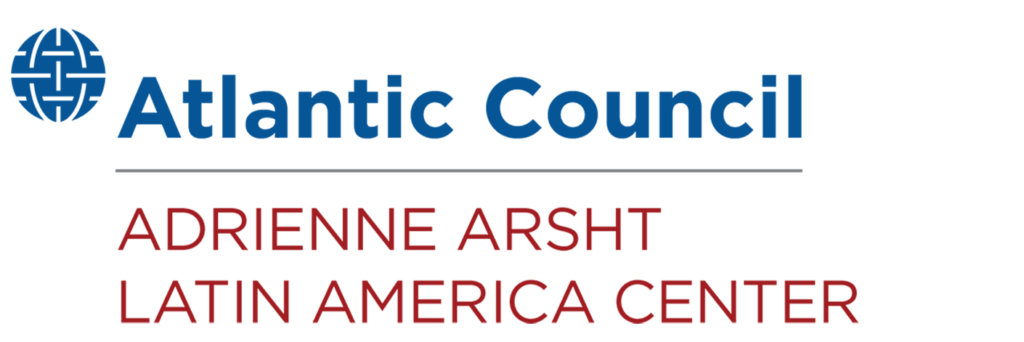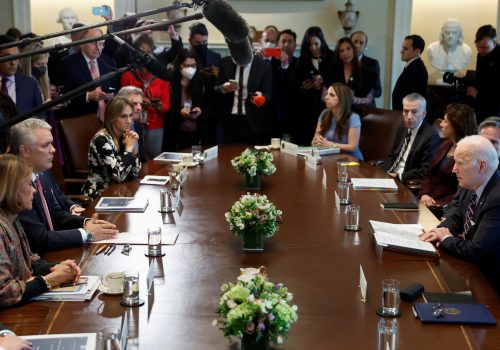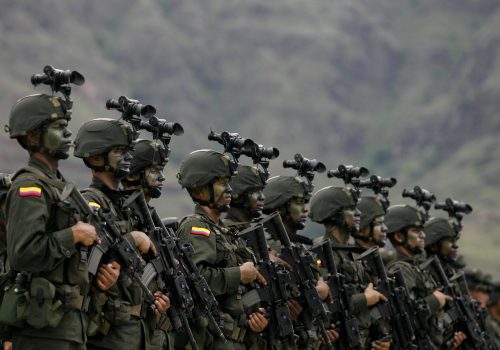Adapt intelligence capabilities for new threats
COLOMBIA’S SECURITY AND DEMOCRACY are at a crossroads. Nearly six years after the Colombian government under then-President Juan Manuel Santos signed a peace agreement with the Revolutionary Armed Forces of Colombia (FARC), the country’s armed conflict remains a reality. Violence is escalating in critical rural and border areas, while urban centers report a deterioration in citizen security. The gains of two decades of sustained US security and intelligence cooperation are increasingly at risk.
A model for bilateral cooperation
Colombia offers a template for a lasting mutually-beneficial security and intelligence partnership with the United States. Through Plan Colombia, the United States provided Colombia, nearing the brink of failed state status in 2000, with security, intelligence, and economic development aid to battle the FARC and other criminal groups. The multi-billion-dollar US program supported Colombia’s efforts to counter narcotics trafficking, train and equip law enforcement and the military, and promote economic growth in areas lacking state presence.1Nick Miroff, “‘Plan Colombia’: How Washington learned to love Latin American intervention again,” Washington Post, September 18, 2016, https://www.washingtonpost.com/world/the_americas/plan-colombia-how-washington-learned-to-love-latin-american-intervention- again/2016/09/18/ddaeae1c-3199-4ea3-8d0f-69ee1cbda589_story.html. This supported an unprecedented whole-of-government approach by then-President Álvaro Uribe, including the “Democratic Security” policy and the multi-year counterterrorism “Patriot Plan.”
Two elements were unique to Plan Colombia. The first was well-coordinated and equipped joint operations between the different branches of Colombia’s armed forces (including shifts in military doctrine). The second was its focus on revamping intelligence capabilities. A combination of US equipment and training assistance gave Colombia’s military renewed confidence.
Colombian security forces—the National Police and military—developed human intelligence, signals intercept capabilities, imagery exploitation, and rapid battlefield damage assessment collection. Superior aerial capabilities allowed security forces to develop operationally actionable intelligence. Military intelligence personnel expanded and intelligence was integrated into military operations.
The United States also worked with civilian intelligence—the Colombian National Intelligence Directorate (DNI)—to incorporate sound intelligence practices with improved oversight of the Colombian National Police and military. This contributed to cutting homicides in Colombia by half and a 90 percent decline in kidnappings and terrorist attacks.2US Global Leadership Coalition, “Plan Colombia: A Development Success Story,” 2015, https://www.usglc.org/media/2017/04/USGLC-Plan-Colombia.pdf.
However, while military intelligence improved, not enough attention was given to enhancing civilian and military intelligence coordination. Future cooperation to strengthen Colombia’s security forces should address this shortcoming, while also focusing on addressing corruption, increasing transparency, and preventing excessive use of force and human rights violations.
A crisis unraveling
Colombia continues to grapple with security and defense challenges, despite the 2016 peace agreement with the FARC. In 2021, the country reached the highest homicide rate since 2014. From January to March 2022, there were twenty-three recorded massacres with sixty-one victims, adding to ninety-six massacres with 338 victims in 2021.3Observatory on Human Rights, Conflict, and Peace, “Massacres in Colombia During 2020, 2021, and 2022,” Indepaz, March 16, 2022, https://indepaz.org.co/informe-de-masacres-en-colombia- durante-el-2020-2021/. There was also a four-year increase in victims of improvised explosive devices between 2017 and 2021.4Lorenzo Caraffi et al., “Colombia: Living in the Shadow of Armed Conflict,” International Committee for the Red Cross, March 23, 2022, https://www.icrc.org/es/document/balance-humanitario-colombia-2022-dih.
With the FARC’s disarmament, conflict centers mainly around the National Liberation Army (ELN), FARC dissidents have sprung up. These include Segunda Marquetalia and FARC-EP, and bandas criminales (BACRIM), including the Gaitanist Self-Defense Forces (also known as the “Gulf Clan”) and the “Border Commands,” previously known as “the Mafia.” By 2021, there were reported to be at least 36 FARC dissident groups with more than 5,200 combatants.5Andres Granadillo, “Mortiferous Territorial Dispute in Colombia between Dissidents of the FARC and the ELN,” France 24, April 1, 2022, https://www.france24.com/es/am%C3%A9rica-latina/20220104-mort%C3%ADfera-disputa-territorial-en-colombia-entre-disidencias-de-las- farc-y-el-eln.
The situation along the porous 1,378-mile Colombia-Venezuela border is particularly tense and often overlooked. Colombia’s Arauca State and Ven- ezuela’s Apure State have become a war zone between FARC dissidents, the ELN, and the Venezuelan military. Violence escalated in 2022 with at least eighty-seven homicides in Arauca by March.6Medellin Editors, “Humanitarian Caravan for Life in Arauca,” Colombia Informa, March 21, 2022, https://www.colombiainforma.info/caravana-humanitaria-por-la-vida-en-arauca/.
Competition to control the lucrative illicit activities market—primarily narco-trafficking, but also illegal mining, counterfeiting, and contraband smuggling—remains the main driver of violence.7Andres Molano Rojas and Juan Moncada, “Illegal economies versus business initiative: Implications of disloyal competition,” Instituto de Ciencia Politica, August 2017, https://www.icpcolombia.org/dev/wp-content/uploads/2017/11/17.08-EN-CONTEXTO-KAS-15-ECONOMIAS-ILEGALES-1.pdf. While the government took important steps to reduce coca cultivation and cocaine production in 2021, a 2015 ban on aerial fumigation with glyphosate maintained by Colombia’s Supreme Court has contributed to all-time highs in coca crops and total cocaine production.8Christine Armario, “US report: Colombia coca production still at record high,” AP News, March 5, 2020, https://apnews.com/article/0aa6474b944f4ff8eb9e7e9cffffce87.
Colombia’s Unified Risk Monitoring Mechanism, a conflict-monitoring instrument of the Special Jurisdiction for Peace (JEP),9The Special Jurisdiction for Peace (JEP) is the transitional justice mechanism instituted by the Colombian government following the 2016 peace agreement with the FARC. identified the twelve areas most afflicted by violence.10Cristina Navarro, “12 Zones Identified in Armed Conflict with Colombia,” Caracol, February 16, 2022, https://caracol.com.co/radio/2022/02/17/judicial/1645060792_011828.html. These regions correlate almost perfectly with areas that report the highest rates of illicit coca production or illicit mining, including the border areas with Ecuador, Panama, and Venezuela, which provide trafficking routes.11“US Department-Level Coca Production Estimates for Colombia,” uploaded by InSightCrime for Scribd, 2016, https://www.scribd.com/document/342745017/US-Department-Level-Coca- Production-Estimates-for-Colombia. There is also a close correlation between the assassination of social leaders and FARC ex-combatants and regions with high narco-trafficking.12“More than 900 social leaders assassinated in Colombia since 2016,” DW, April 19, 2021, https://www.dw.com/es/m%C3%A1s-de-900-l%C3%ADderes-sociales-asesinados-en-colombia-desde-2016/a-57257906. This demonstrates the state’s failure to recover FARC-era strongholds, with military and institutional presence seen only in sporadic raids.13Latin America and the Caribbean, “A Fight by Other Means: Keeping the Peace with Colombia’s FARC,” International Crisis Group, November 30, 2021, https://www.crisisgroup.org/latin-america-caribbean/andes/colombia/092-fight-other-means-keeping-peace-colombias-farc. Citizen insecurity in major urban centers is also rising, including acts of terrorism.14Vanessa Perez Diaz, “National Concern Over Deterioration of Urban Security in the Country Throughout 2021,” Asuntos Legales, March 12, 2021, https://www.asuntoslegales.com.co/actualidad/preocupacion-por-el-deterioro-de-la-seguridad-urbana-en-el-territorio-nacional-3138426.
Opportunities ahead
The tactics used in today’s conflicts are sophisticated. Intelligence is the first line of defense. Unfortunately, early investments in military intelligence and much-needed civilian intelligence reforms did not focus adequately on creating a Colombian intelligence community. Intelligence cooperation must now focus on building this community, fostering sharing intelligence, and countering the threats posed by criminal actors operating with smaller cells, sophisticated courier networks, and a growing dark web footprint.15Timothy Quintero, “The Connected Black Market: How the Dark Web Has Empowered LatAm Organized Crime,” InSightCrime, September 13, 2017, https://insightcrime.org/news/analysis/connected-black-market-how-dark-web-empowered-latam-organized-crime/.
The DNI, Colombia’s primary civilian intelligence organization, must be strengthened to coordinate more closely with military intelligence. While the DNI produces analysis and is responsible for counterintelligence activities, it operates in silos from the intelligence organizations of the National Police, Air Force, Army, and Navy. Fusing intelligence—taking disparate types of intelligence collection and combining them to provide more operationally relevant information—should be a priority moving forward. Ensuring national-level civilian combat support agencies supplement the military is also crucial.
How could the United States support these improvements?
First, the United States should support the creation of joint committees and civilian combat support units to improve US-Colombia intelligence collaboration. These efforts should build on successful experiences and incorporate technical support from the United States and other allies across the world like Israel and the United Kingdom.
Second, the United States should work with Colombia to update the strategy and equipment used to target border violence, conflict hotspots, and the financial operations of criminal actors. Colombia could better staff the DNI and commit to evaluating how bureaucratic and administrative hurdles limit efficacy and contribute to corruption. With US support, Colombia should also enhance efforts to improve human rights and professional standards.
Third, the whole-of-government approach that recovered territorial control in certain areas during Plan Colombia should be restored. The Colombian government should focus on setting measurable objectives to reduce the size of the BACRIM and remaining FARC disenfranchised personnel, while reevaluating the more traditional warfare approach it adopted following the peace agreement. An incoming government should prioritize a strategy that synchronizes security, intelligence, economic development, and human rights objectives in high-risk territories.
Finally, the United States and Colombia should prioritize bilateral strategic security dialogues that build on the framework provided by the US-Colombia High Level Dialogue. Future dialogues should incorporate interagency participation and focus on combating armed non-state actors, strengthening US support for Colombia’s whole-of-government approach to the conflict.
Both the United States and Colombia must recognize the gravity of large swathes of Colombian territory in the hands of new criminal actors. In March 2022, President Joseph R. Biden announced his intention to designate Colombia as a Major non-NATO ally, signaling the importance of the bilateral security partnership and granting Colombia preferential access to trade and security cooperation.16“Joint Statement by President Joseph R. Biden and President Iván Duque Marquez of the Republic of Colombia, US-Colombia Bicentennial Partnership,” The White House, March 10, 2022, https://www.whitehouse.gov/briefing-room/statements-releases/2022/03/10/joint-statement-by-president-joseph-r-biden-jr-of-the-united-states-and-president-ivan-duque-marquez-of-the-republic-of-colombia-u-s-colombia-bicentennial-partnership/. Colombia stands as the only country in Latin America designated as a NATO Global Partner.
Colombia: A vital partner in the hemisphere
The United States and the Western Hemisphere benefit from a strong partnership with Colombia. Its security gains in the last two decades have positioned it as Latin America’s third-largest economy and an indispensable security partner to the US, training police and prosecutors in Latin America and other regions. With a new yet focused strategy in place, Colombia is well-positioned to reverse the tide of transnational organized crime afflicting our hemisphere.
US intelligence and security cooperation with Colombia bore positive results for both countries over the past two decades. It would be unwise to overlook a partner with a demonstrated record of results and a willingness to learn from past mistakes. With current and looming internal and external threats to Colombia’s democratic future, too much is at stake to disregard the lessons learned of a fruitful partnership and apply those lessons to this vital relationship in the Americas.
* * *
Kiron K. Skinner is the Taube Professor for International Relations and Politics at Carnegie Mellon University’s Institute for Politics and Strategy. Skinner formerly served at the US Department of State as the director for policy planning and senior adviser to the secretary of state. Skinner is a life-time director on the board of the Atlantic Council and a visiting fellow at the Heritage Foundation’s Kathryn and Shelby Cullom Davis Institute for National Security and Foreign Policy.
David R. Shedd is a former deputy director of national intelligence for policy, plans, and requirements. Between 2005 and 2007, Shedd served as chief of staff and acting director of the intelligence staff to the director of national intelligence. He also held several posts at the National Security Council from 2001 to 2005, including special assistant to the president and senior director for intelligence programs and reform.
Related Allies essays
Related program

The Adrienne Arsht Latin America Center broadens understanding of regional transformations and delivers constructive, results-oriented solutions to inform how the public and private sectors can advance hemispheric prosperity.
Image: Uniformed and civilian cyber and military intelligence specialists monitor Army networks in the Cyber Mission Unit’s Cyber Operations Center at Fort Gordon, Ga. (Photo by Michael L. Lewis, US Army Cyber Command Flickr)


